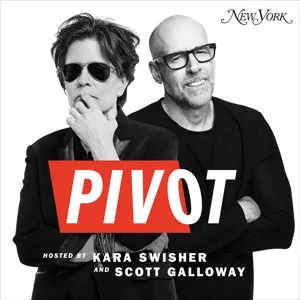Podcast Summary
The importance of solving a sharp problem in building a successful product.: Solving a problem and providing value to users is crucial for the success of a product, rather than solely focusing on synthetic virality.
Building a great product that solves a sharp problem is the bedrock of virality. Oji Udezue emphasizes that products that try to be viral just for synthetic virality often fail. If a product is synthetically viral but ultimately disappointing, it will not succeed. However, a product like Slack, which wasn't initially viral, gained traction through word of mouth because it solved a problem for organizations. Oji highlights the importance of focusing on the problem space when building software companies, especially in the B2B SaaS industry. Understanding the problem you are solving and predicting the success of your solution is crucial. Both investors and operators should consider this when evaluating potential ideas and investments.
Segmenting the Market Based on Workflow Frequency and Breadth: Segmentation based on workflow frequency and breadth can provide predictive power for decision-making, with the most profitable quadrant being high ni, focused on highly frequent niche workflows.
Segmenting the market based on the frequency and breadth of workflows can provide predictive power and help guide decisions for both founders and investors. Oji Udezue explains that workflows can be categorized into four quadrants: high ni (high frequency niche), high everyone (high frequency applicable to all departments), low frequency niche, and low frequency everyone. He states that high everyone workflows, such as email and collaboration, are dominated by large companies like Microsoft and Google. The most profitable quadrant to work on is high ni, which focuses on niche workflows that are highly frequent. While it may be more challenging to succeed in the other two quadrants, there are still opportunities, and the framework provides guidance on navigating those spaces. The frequency of workflows is generally considered every day or multiple times a week for frequent, while infrequent can be as low as once a month. It's worth noting that this framework is dynamic, and companies are not limited to one specific quadrant.
Understanding audience frequency and market share for successful product development.: Developing a product that offers significant value and productivity compared to alternatives is essential for capturing a larger market share and prompting customers to switch.
When developing a product or solution, it is crucial to understand the frequency and target audience of the workflow you are addressing. Moving from a low frequency niche to a high frequency niche can be highly beneficial for a business, as it allows them to capture a larger market share. Expanding the foothold in a specific kind of customer can lead to increased success and profitability. Additionally, the concept of the "zone of benefit" highlights the importance of creating a product that significantly improves upon the status quo. To truly make an impact, the product should offer at least two to three times more value or productivity to the user than the alternatives. This noticeable difference is what will prompt customers to consider switching to a new solution.
Importance of Identifying Your Ideal Customer Profile (ICP): Identifying your ICP helps you understand your target audience, tailor your product and marketing efforts, and attract and retain the right customers for the success of your product or startup.
Identifying your Ideal Customer Profile (ICP) is crucial for the success of your product or startup. Your best customers are those who truly understand the value your product offers and are not price sensitive. Once you start gaining a decent audience, pay attention to the people who show genuine interest and care about your product, as they are likely your target audience. Examples from companies like Atlassian, Calendly, Typeform, and Twitter demonstrate how different businesses have different ICPs. For Twitter, their ICP is bifurcated, consisting of accomplished individuals who have something to say and attract a wide range of followers, creating informal communities around shared interests. Understanding your ICP helps tailor your product and marketing efforts to attract and retain the right customers.
The Importance of Adapting Frameworks and Mental Models: Adapting frameworks and mental models to different stages of a product or business is crucial for effective product management. Understanding the fundamentals behind them allows for more productive use in uncertain and unknown situations.
Frameworks and mental models can be valuable tools in product management, but it's important to go deeper and understand the fundamentals behind them. Oji Udezue emphasizes the need to adapt frameworks and mental models to different stages of a product or business, rather than using them blindly. He believes that understanding the fundamentals and the empirical relationships that construct a framework is crucial due to the uncertainty and unknowns in product management. While he appreciates frameworks, he urges listeners to not rely on them blindly, as this can be harmful to their businesses. Overall, a deeper understanding of the fundamentals allows for more productive use of frameworks in different contexts.
Starting with the Right Problem for Product-Led Growth: To achieve success in Product-Led Growth, it is essential to choose a problem that causes significant pain points for customers, as solving these sharp problems increases the likelihood of customers being willing to pay for the solution.
When it comes to Product-Led Growth (PLG), it is crucial to start with a sharp problem. Choosing a problem that is materially felt by customers, causing them to experience pain points in terms of time, energy, money, and focus, is more likely to lead to success. Innovation should be inspired by understanding customers and their problems, rather than solely relying on personal ideas or inspirations. By solving sharp problems, founders can expect customers to be willing to pay for the solution. On the other hand, working on non-sharp problems may require significant investments in marketing and word-of-mouth to gain traction, making it easier to fail. When assessing the sharpness of a problem, comparing the current workflow with the potential workflow after using the software can be a helpful indicator.
Understanding and Measuring Customer Workflows for Effective Problem Solving: By engaging with both potential and current customers, businesses can identify impactful problems and optimize workflows through continuous discovery and listening efforts.
Understanding and measuring customer workflows is crucial for identifying sharp problems that need to be solved. By talking to both pre-customers and enthusiastic post-customers, one can gauge whether a problem is truly impactful. The whites of their eyes, dilated pupils, and nods of understanding indicate a genuine excitement and need for a solution. However, it is important to differentiate between excitement and real workflow optimization. Continuous customer discovery, through regular conversations and feedback, is essential for refining and optimizing workflows. This can be facilitated through tools like Calendly and Typeform, ensuring that all relevant team members regularly engage with customers. Additionally, customer listening, through social media, app stores, surveys, bug reports, customer support, and sales data, provides valuable signals for identifying customer needs and preferences.
Listening to customers and merging customer delight with business ambition is crucial for effective product management.: By actively seeking feedback and communication from the right customers, businesses can drive customer retention and achieve product success.
Effective product management involves efficiently processing customer signals and understanding what matters from a customer delight perspective. Oji Udezue emphasizes the importance of listening and melding customer delight with business ambition. He acknowledges that the industry can improve in this area and shares the tactic of using a popup on the website to invite visitors to provide feedback and book meetings. It is crucial to target the right customers and present the opportunity for communication during their activation or conversion journey. Lenny agrees with this approach and mentions the positive impact Oji has had on his life through the products he has built. Ultimately, the conversation highlights the significance of effective product discovery and the power of onboarding in driving customer retention and product success.
The Importance of Effective Onboarding in Product-Led Growth: Effective onboarding is crucial in the PLG model as it can replace traditional sales and account management teams. It should focus on understanding the buyer's mindset, utilizing social psychology, and providing value throughout the buyer's journey.
Onboarding is crucial for success in the Product-Led Growth (PLG) model. Effective onboarding can replace traditional sales and account management teams for a large number of customers. The goal is to make the onboarding process feel as human-like, friendly, and approachable as possible. Onboarding is about understanding the mindset of the buyer and evaluator, utilizing social psychology rather than focusing solely on the product itself. The offline industry, such as those who stock shelves or provide inventory online, have a wealth of knowledge in this area. Onboarding should support the buyer's journey through value proposition understanding, simplicity, value provided, and decision-making. It consists of mandatory setup, which should be short and essential, and optional elements that can be helpful for those who are curious. Effective onboarding should be clear, concise, and tailored to each product's specific needs.
Importance of Activation Milestones and Network Effects in User Engagement and Retention: Defining clear activation milestones and leveraging network effects are critical for user engagement and the success of platforms, allowing them to overcome challenges and competition.
Activation milestones are crucial for ensuring user engagement and retention in various products and platforms. Oji Udezue highlights the importance of defining clear thresholds for increasing activation and guiding users through each milestone. Examples of activation milestones include creating a first meeting in Calendly, publishing a form and receiving responses in Typeform, and following and being followed by others in Twitter. Lenny humorously acknowledges the somewhat creepy nature of Twitter's activation milestone requirement. Oji emphasizes that network effects play a significant role in the success of social networks. Network effects occur when the value of a network increases as more people join, and it is a powerful feature that can sustain a platform despite challenges or competition.
The Power of Network Effects and Virality in Business and Software: Network effects are crucial for the success of businesses and software, as they attract advertisers and create a positive feedback loop. Building a great product that effectively solves a problem is the key to increasing virality.
Network effects play a crucial role in the success and sustainability of businesses and software. Advertisers are attracted to platforms like Twitter because of the large user base, creating a positive feedback loop. Even when other aspects of a business are stripped away, network effects can still hold immense power. This is evident in Twitter's case, where Elon Musk and his team have focused on maintaining the network effects while removing other elements. The conversation also touches on the concept of virality, emphasizing that it is not just about superficial tactics, but rather the quality of word-of-mouth marketing and customer satisfaction. Ultimately, building a great product that effectively solves a problem is the foundation for increasing virality.
The Importance of Building a High-Quality Product for Virality: Building a high-quality product is crucial for achieving viral success by providing a positive user experience, fostering word-of-mouth marketing, and reducing marketing expenses through customer engagement and organic growth.
Building a high-quality product is crucial for achieving virality. Calendly's success can be attributed to its simplicity, respect for schedulers' time, and overall great user experience. Previous versions of similar products lacked these qualities and thus failed to go viral. Additionally, customer support plays a significant role in virality. Providing exceptional customer support creates a positive relationship with users, leading to word-of-mouth marketing and increased adoption. While other factors like viral tactics and network effects contribute to virality, a great product remains the foundation. It is important to prioritize building the best possible product in order to achieve viral success. By doing so, companies can rely on customer engagement and augmented marketing to reduce marketing expenses and drive organic growth.
The Importance of "Forest Time" in Product Development and Problem-Solving.: Taking a step back from daily tasks to gain a broader perspective can lead to improved decision-making, better execution, and more efficient use of time and resources.
Taking time for "forest time," or stepping back to see the bigger picture, is essential for effective product development and problem-solving. Often, we get caught up in the day-to-day tasks and focus solely on the immediate problems in front of us. However, to find alternative paths and solutions, it's crucial to intentionally elevate ourselves and gain a bird's eye view of the entire landscape. Forest time can be dedicated to creating workflows, worksheets, or surveys that help us assess the bigger picture and explore different options. By allowing ourselves and our teams this time for reflection and strategic thinking, we can improve our aim, enhance execution, and avoid wasting time and resources on incorrect paths. It's about working smarter, not harder.
Bridgewater's lesson on evaluating talent holistically and the importance of organizational frameworks.: Evaluating individuals based on skills, attributes, and values leads to better outcomes, and effective organizational frameworks are crucial for success.
Bridgewater taught Oji Udezue an important lesson about looking at talent and people in three dimensions: skills, attributes, and values. While many organizations focus solely on skills, Bridgewater recognized the importance of considering attributes and values when evaluating individuals. This approach enhanced Udezue's success in both his professional and personal life. He now applies this perspective when interviewing people and believes it improves outcomes. Additionally, the conversation highlights the need for a product and business abstraction above agile and design thinking in order to build solid organizations and execute well. Overall, the key takeaway is the value of considering all aspects of a person and the importance of developing effective organizational frameworks.
Assessing the value of books and finding meaningful insights: Analyze and deconstruct the content of books to separate storytelling from insights. Read science fiction for pleasure and expand knowledge from the world outside.
Assessing the value of business and self-help books can be challenging, but "The Halo Effect" provides a framework for distinguishing what is important from what is not. It emphasizes the need to analyze and deconstruct the content of these books, separating circumstantial storytelling from meaningful insights. Additionally, the conversation highlights the significance of reading for pleasure, particularly in the genre of science fiction. "Dune" by Frank Herbert and "Foundation" by Asimov are highly recommended for their exceptional world-building. The conversation also touches on optimizing workspaces and an appreciation for both Windows and Mac systems. Ultimately, the key motto shared is the recognition that there is always more knowledge to gain from the world outside one's own mind.
Embracing curiosity and connection for personal and professional growth.: Stay curious, skeptical, and humble. Embrace active listening and value diverse perspectives. Reach out, collaborate, and support others to make a positive impact.
Curiosity and open-mindedness are essential qualities for personal and professional growth. Oji Udezue emphasizes the importance of being curious, skeptical, and humble about our knowledge and always seeking to learn more. He encourages active listening and valuing the perspectives of others, as they can provide valuable insights to expand our understanding. This mindset of curiosity extends beyond professional fields and applies to exploring different cultures and experiences. Additionally, the conversation highlights the significance of reaching out, collaborating, and supporting one another. Oji Udezue invites people to connect with him online, participate in the creation of his book, and join a community of like-minded individuals to collectively contribute and make a positive impact.







